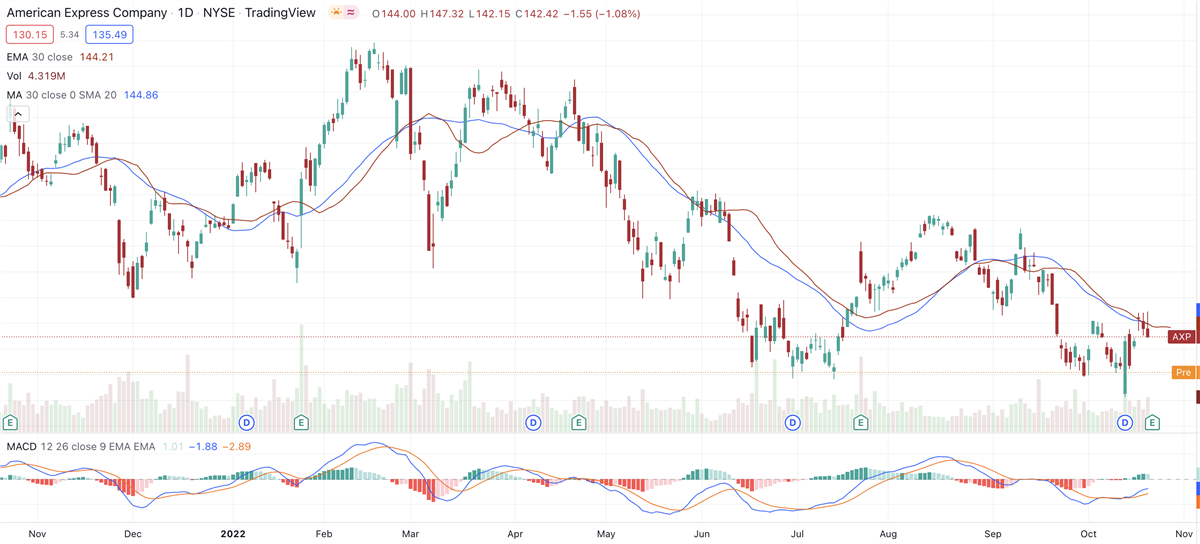 Dow component American Express (NYSE: AMEX) was trading 5% lower in the pre-market Friday following the company’s third-quarter earnings report.
Dow component American Express (NYSE: AMEX) was trading 5% lower in the pre-market Friday following the company’s third-quarter earnings report. That may sound like the company missed views, but in fact, it beat on both the top and bottom line, and boosted its full year guidance. The broader indexes were trading lower ahead of the open Friday. Concerns about higher interest rates are among concerns for American Express, despite better-than-expected results.
American Express’ profit came in at $2.47 per share, ahead of expectations for $2.40 per share, and up 8.8% from the year-ago quarter. Revenue was $13.6 billion, up 21% from last year’s third quarter. That was also ahead of views; analysts had forecast $13.5 billion in sales.
If you check MarketBeat earnings data for American Express, you’ll find that it topped both earnings and revenue expectations in each of the past five quarters.
In the earnings release, CEO Stephen Squeri outlined some reasons behind the growth. He noted that overall spending among the card member base grew 21%, driven by growth in both the Goods & Services and Travel & Entertainment segments.
He said, “The demand for travel has exceeded our expectations throughout the year, with spending on T&E increasing 57%t from a year earlier and T&E spending volumes in our international markets surpassing pre-pandemic levels for the first time this quarter …”
Squeri also said the company added more cardholders in the quarter, with millennial and Gen Z customers driving the growth.
In the release, American Express said, “Based on the company’s performance to date, it continues to expect full-year revenue growth of 23% to 25% and now expects to be above its original full-year EPS guidance range of $9.25 to $9.65.”
Prior to the earnings release, American Express notched a year-to-date decline of 10.78%, outpacing the Dow, which is down 13.71% in 2022.
In February, the stock broke out of a 15-week consolidation, but the breakout quickly broke down, as the broader market, in the form of the Dow and, more importantly, the S&P 500, were rolling over.
Despite outperforming the wider market, American Express’ technicals remain poor. Shares closed Thursday at $142.42, down $1.55, or 1.08%. That was above both the 10-day and 21-day moving averages, but 13% below the 200-day average, and 5.1% below the 50-day line.
It’s not considered a sign of strength when a stock is trading below its 200- and 50-day lines. You also don’t want to see the longer-term price lines are above shorter-term averages, like the 10- and 21-day lines.
Unfortunately, that’s exactly the case with American Express, where the medium-term trend has been lower.
When it comes to earnings growth, which ultimately drives institutions to purchase shares, American Express fizzled recently, posting a flat quarter and most recently, an 8% decline.
Prior to Friday’s report, Wall Street had pegged American Express’ full-year earnings at $9.92 per share, down 1% from 2021. That consensus estimate was revised lower recently. Next year, analysts see the company earning $11.14 per share, which would mark an increase of 12%.
Analyst data for American Express compiled by MarketBeat show a “hold” rating on the stock, with a price target of $174, a 22.17% upside.
However, in what may seem contradictory, seven analysts in October alone downgraded the stock or slashed their price targets. Even so, all but Credit Suisse and Citigroup continue seeing upside in the stock.
Within the financials sector of the S&P 500, as tracked by the Financial Select Sector SPDR ETF (NYSEARCA: XLF) American Express is the tenth most heavily weighted stock. Sector performance is most influenced by top holdings Berkshire Hathaway (NYSE: BRK.B) and JPMorgan Chase (NYSE: JPM), which weight in at 14.46% and 9.83%, respectively.
None are stellar performers at the moment, but of the three, Berkshire Hathaway is the least bad, with a year-to-date decline of just 6.91%. The S&P financials sector is down 18.41%.

